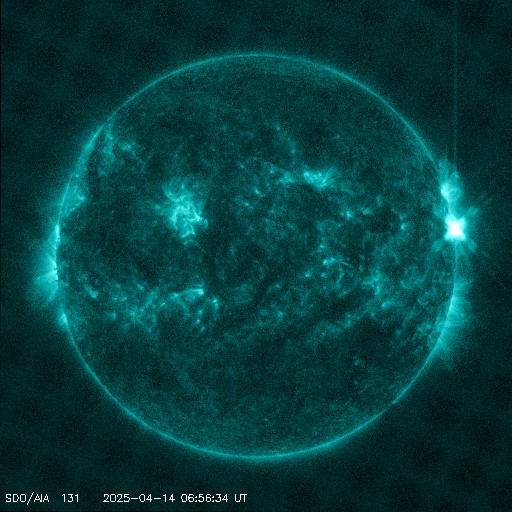Viewing archive of Monday, 1 August 2005
Solar activity report
Any mentioned solar flare in this report has a scaling factor applied by the Space Weather Prediction Center (SWPC). Because of the SWPC scaling factor, solar flares are reported as 42% smaller than for the science quality data. The scaling factor has been removed from our archived solar flare data to reflect the true physical units.
Report of Solar-Geophysical Activity 2005 Aug 01 2204 UTCPrepared by the NOAA © SWPC and processed by SpaceWeatherLive.com
Joint USAF/NOAA Report of Solar and Geophysical Activity
SDF Number 213 Issued at 2200Z on 01 Aug 2005IA. Analysis of Solar Active Regions and Activity from 31-2100Z to 01-2100Z
Solar activity was at moderate levels. Region 792
(N12E25) produced the largest flare during the period, a long
duration M1/1f flare that occurred at 01/1351Z. This event
generated an associated Tenflare (290 sfu), a Type IV radio sweep,
and a CME that may have a weak geoeffective component. Region 792
underwent a decrease in sunspot number however, sunspot area has
remained the same. This region continues to exhibit
beta-gamma-delta magnetic features. Region 794 (S11E60) produced
the second largest flare during the period, a C5 x-ray event that
occurred at 01/1221Z. This region has shown growth in sunspot area
over the interval. No new regions were numbered today.
IB. Solar Activity Forecast
Solar activity is expected to be at
moderate levels. Region 792 is capable of producing M-class flares.
IIA. Geophysical Activity Summary 31-2100Z to 01-2100Z
The geomagnetic field was at quiet to active levels. The elevated
activity may be attributed to a weak transient that was observed at
the ACE spacecraft at approximately 01/0500Z. The greater than 10
MeV proton event that began at 27/2300Z ended at 01/1040Z, a maximum
of 41 pfu occurred at 29/1715Z.
IIB. Geophysical Activity Forecast
The geomagnetic field is
expected to be at predominantly quiet to unsettled levels. Isolated
active conditions are possible on 04 August due to a glancing blow
from the CME that was associated with the M1/1f flare that occurred
today.
III. Event Probabilities 02 Aug to 04 Aug
| Class M | 70% | 70% | 70% |
| Class X | 15% | 15% | 15% |
| Proton | 20% | 20% | 20% |
| PCAF | yellow | ||
IV. Penticton 10.7 cm Flux
Observed 01 Aug 111 Predicted 02 Aug-04 Aug 110/105/105 90 Day Mean 01 Aug 096
V. Geomagnetic A Indices
Observed Afr/Ap 31 Jul 010/009 Estimated Afr/Ap 01 Aug 015/015 Predicted Afr/Ap 02 Aug-04 Aug 012/015-005/005-012/015
VI. Geomagnetic Activity Probabilities 02 Aug to 04 Aug
| A. Middle Latitudes | |||
|---|---|---|---|
| Active | 30% | 15% | 30% |
| Minor storm | 10% | 05% | 10% |
| Major-severe storm | 05% | 01% | 05% |
| B. High Latitudes | |||
|---|---|---|---|
| Active | 35% | 20% | 35% |
| Minor storm | 15% | 05% | 15% |
| Major-severe storm | 05% | 01% | 05% |
All times in UTC
Current data suggests there is a slight possibility for aurora to appear at the following high latitude regions in the near future
OuluArkhangelsk, Vorkuta
Umeå
Latest news
Latest forum messages
Potential AR4062 7AR 4055 97Unspecified geomagnetic activity 2254Incoming & Unnumbered Active Regions 1698AR 4060 23
More topicsSupport SpaceWeatherLive.com!
A lot of people come to SpaceWeatherLive to follow the Sun's activity or if there is aurora to be seen, but with more traffic comes higher server costs. Consider a donation if you enjoy SpaceWeatherLive so we can keep the website online!

Latest alerts
07:09 UTC - Solar flare
Moderate M4.28 flare from sunspot region 4055
06:48 UTC - Radio Blackout
Minor R1 radio blackout in progress (≥M1 - current: M1.53)
06:24 UTC - Solar flare
Moderate M1.49 flare from sunspot region 4055
06:06 UTC - Radio Blackout
Minor R1 radio blackout in progress (≥M1 - current: M1.16)
04:45 UTC - Geomagnetic activity
Active geomagnetic conditions (Kp4) Threshold Reached: 04:29 UTC
Space weather facts
| Last X-flare | 2025/03/28 | X1.1 |
| Last M-flare | 2025/04/14 | M4.2 |
| Last geomagnetic storm | 2025/04/06 | Kp5 (G1) |
| Spotless days | |
|---|---|
| Last spotless day | 2022/06/08 |
| Monthly mean Sunspot Number | |
|---|---|
| March 2025 | 134.2 -20.4 |
| April 2025 | 132.1 -2.1 |
| Last 30 days | 132.4 -10.7 |





